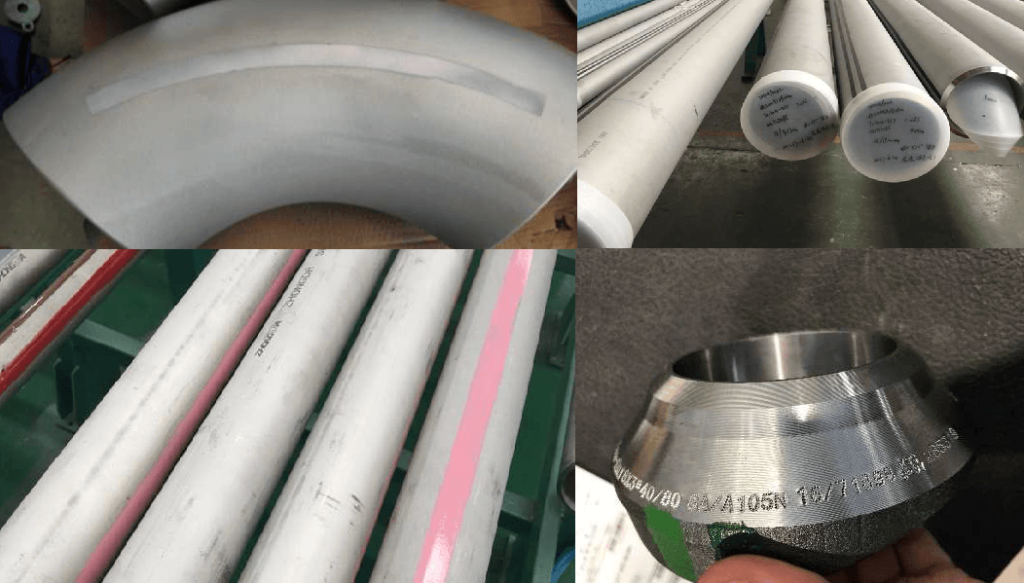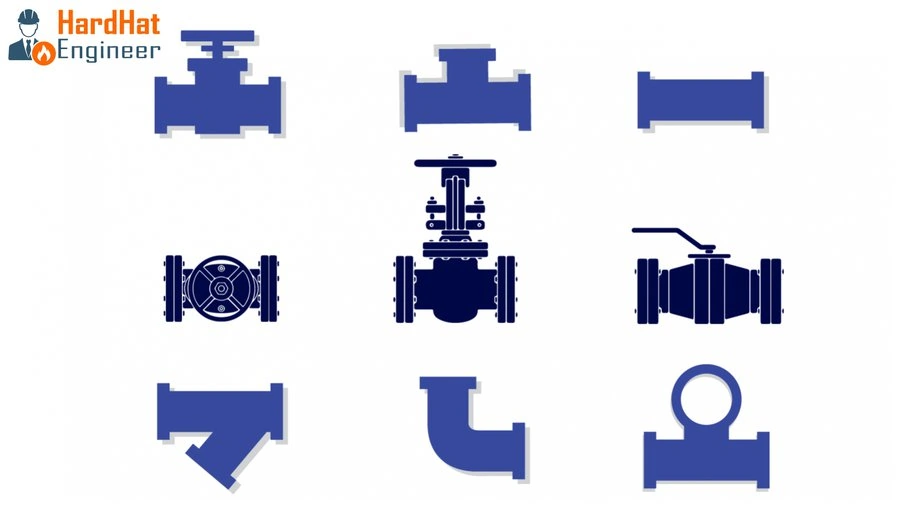There are different types of stainless steel used in piping. After carbon steel, Stainless Steel is the second most widely used material in Process industries as it offers excellent corrosion resistance properties.
Stainless steel (SS) is a type of alloy steel with a minimum chromium content of 10.5% or more and maximum carbon content of less than 1.20%.
SS has excellent resistance to corrosion and good ductility. Stainless steel becomes corrosion resistive due to the formation of non-reactive chromium oxide (Cr2O3) film on the surface. This film adheres tightly to the surface of the metal, which acts as a barrier, protecting the metal from corrosion.
Stainless Steel properties got changed when its microstructure changed. Based on this, SS can be classified as follow;
Table of Contents – Types of Stainless Steel
Austenitic stainless steel
Austenitic stainless steel is a type of stainless steel with several advantageous properties. I have listed some of them below;
- Austenitic stainless steel is non-magnetic and has very high corrosion resistance:
It does not attract magnets and is resistant to rust and corrosion caused by exposure to various environments, such as moisture, chemicals, and acids.
This property makes it suitable for applications where corrosion resistance is crucial, such as in marine environments or chemical processing plants.
- Excellent weldability, formability, fabricability, and ductility:
Austenitic stainless steel is known for its superior weldability, allowing it to be easily joined or welded to other materials. It is also highly formable, meaning it can be shaped and manipulated into various complex forms without losing its structural integrity.
Additionally, it has excellent fabricability, enabling it to be easily fabricated into different components or structures. It also exhibits high ductility, meaning it can undergo deformation without fracturing, making it more resistant to cracking or breaking.
- High corrosion resistance at temperatures up to 1500°F:
It is a type of stainless steel that maintains its corrosion resistance even at high temperatures, making it suitable for applications that involve elevated temperatures, such as industrial furnaces or high-temperature processing equipment.
- Useful for both low and high-temperature service:
Austenitic stainless steel exhibits good mechanical properties over a wide temperature range, making it suitable for both low-temperature and high-temperature applications.
It retains its strength and toughness even at extremely low temperatures, making it suitable for cryogenic applications, as well as at elevated temperatures.
- This type of stainless steel is hardenable by cold working:
Austenitic stainless steel can be hardened by cold working processes, such as rolling, bending, or hammering, which induce plastic deformation in the material.
Cold working increases the strength and hardness of the steel, enhancing its mechanical properties.
- It has a face-centered cubic (FCC) structure:
Austenitic stainless steel possesses a fine-grain structure known as face-centered cubic (FCC), where the atoms are arranged in a closely packed cubic lattice.
This structure contributes to the material’s excellent mechanical properties, including strength, ductility, and toughness.
- Possesses high impact strength at low temperatures:
It maintains its impact strength even at low temperatures, which is crucial for applications in cold environments or where the material may be subjected to sudden impacts or loads.
These types of stainless steel are widely used in the process industry and various industrial applications, and cookware is also manufactured from austenitic stainless steel.
Due to its excellent corrosion resistance, weldability, and formability, austenitic stainless steel finds extensive use in industries such as chemical processing, oil and gas, food and beverage, pharmaceuticals, and many others. It is also commonly used to produce cookware due to its hygienic properties, corrosion resistance, and aesthetic appeal.
Examples of austenitic stainless steel include Type 304, 304L, 316, and 316L. These grades are widely utilized in various industries and offer specific compositions and properties tailored to specific applications. Refer to the chart given below.
| Grade | Alloy Component | Characteristics & Application |
|---|---|---|
| 303 | 18Cr-8Ni-S | Free cutting steel |
| 304 | 18Cr-8Ni | Basic steel grade. Use for general purpose steel for many applications in many fields |
| 304H | 18Cr-8Ni-High C | |
| 304L | 18Cr-8Ni-Low C | |
| 304N | 18Cr-8Ni-N | High strength |
| 304LN | 18Cr-8Ni-Low C-N | lntergranular corrosion resistance |
| 309 | 22Cr-12Ni | Oxidation resistance. Use in Chemical plant pipes and tubes, Radiant tubes, Thermocouple protection tubes |
| 309S | 22Cr-12Ni | |
| 310 | 25Cr-20Ni | |
| 310S | 25Cr-20Ni | |
| 312L | 20Cr-18Ni-6Mo-0.2N | Seawater resistance. Use in Seawater desalination plant pipes |
| 316 | 18Cr-12Ni-2Mo | Corrosion resistance. Use in LNG plant pipes, Boilers, nuclear power and chemical industry pipes and tubes |
| 316H | 18Cr-12Ni-2Mo-High C | |
| 316L | 18Cr-12Ni-2Mo-Low C | |
| 316Ti | 18Cr-12Ni-Mo-Ti | lntergranular corrosion resistance |
| 317 | 18Cr-12Ni-3Mo | Pitting corrosion resistance. Use in Chemical tanker pipes |
| 317L | 18Cr-12Ni-3Mo-Low C | |
| 321 | 18Cr-9Ni-Ti | Intergranular corrosion resistance. Use in Chemical plant pipes |
| 321H | 18Cr-9Ni-Ti-High C | High-temperature strength. Use in Boiler heater tubes and reheater tubes |
| 347 | 18Cr-9Ni-Nb | lntergranular corrosion resistance. Use in Chemical plant pipes and tubes |
| 347H | 18Cr-9Ni-Nb-Low C | High-temperature strength. Use in Boiler heater tubes and reheater tubes |
| 310MoLN | 25Cr-22Ni-2Mo-N | lntergranular corrosion resistance. Use in Urea reactor tubes |
Piping Component Quiz – Test yourself, Take This Quiz
Unlock New Skills with Our Best Selling Online Courses
Ferritic stainless steel
Ferritic stainless steel is a type of stainless steel that differs from austenitic stainless steel in several aspects. Refer to the points given below to know more about that.
Ferritic stainless steel is magnetic and contains high carbon, making it brittle and having relatively poor corrosion resistance compared to austenitic stainless steel.
Unlike austenitic stainless steel, ferritic stainless steel is magnetic due to its microstructure. It contains higher carbon content, which contributes to its increased brittleness and decreased corrosion resistance.
The presence of carbon can lead to the formation of carbides, reducing the material’s ability to withstand corrosion and making it more susceptible to cracking and fracture.
Non-hardenable by heat treatment:
Unlike some other types of stainless steel, ferritic stainless steel is not easily hardened through heat treatment processes. Its microstructure does not undergo significant changes when subjected to heating and cooling cycles, limiting the ability to enhance its mechanical properties through heat treatment.
Body-centered cubic (BCC) structure:
Ferritic stainless steel has a coarse-grain structure known as body-centered cubic (BCC), where the atoms are arranged in a cubic lattice with a single atom at the center of each cube.
This structure affects the material’s mechanical properties and can contribute to its brittleness and decreased ductility compared to austenitic stainless steel.
Ferritic stainless steel has high resistance to chloride stress corrosion cracking:
One notable advantage of ferritic stainless steel is its high resistance to chloride stress corrosion cracking. This type of corrosion occurs in environments with high chloride content, such as marine environments or environments containing chlorides from chemicals.
Due to its resistance to this specific form of corrosion, ferritic stainless steel is commonly used in applications such as marine equipment, petrochemical plants, heat exchangers, and furnaces.
Type 409, 430, 439, 444, and 446 are examples of Ferritic stainless steel. Refer to the chart given below.
| Grade | Alloy Component | Characteristics & Application |
|---|---|---|
| 430 | 18Cr | Chloride corrosion resistance and stress corrosion crack resistance. Use in water heater pipes |
| 444 | 19Cr-2Mo-Ti/Nb | |
| 446 | 25Cr-N |
Martensitic stainless steel
Martensitic stainless steel is a type of stainless steel that possesses distinctive properties different from both austenitic and ferritic stainless steel.
Martensitic stainless steel has high hardness and poorer corrosion resistance compared to austenitic stainless steel:
Martensitic stainless steel is known for its high hardness, making it one of the hardest types of stainless steel available. However, it typically has lower corrosion resistance compared to austenitic stainless steel.
The lower corrosion resistance is due to the higher carbon content and the absence of nickel, which reduces the material’s ability to resist corrosion and makes it more prone to rusting and staining.
Heat treatable to high hardness levels:
Martensitic stainless steel can be heat treated to achieve high hardness levels through a process known as quenching and tempering.
The steel is rapidly cooled (quenched) to form a hardened structure and then tempered to adjust the hardness and improve the material’s toughness. This heat treatment process allows for precise control over the mechanical properties of the steel.
Crystallographic form-distorted structure:
Martensitic stainless steel transforms its crystallographic structure during heat treatment. It changes from a face-centered cubic (FCC) structure to a body-centered cubic (BCC) structure, resulting in a distorted lattice structure.
This transformation contributes to the material’s increased hardness and strength.
It is used in the manufacturing of sports knives and multi-purpose tools:
Due to its high hardness and good wear resistance, martensitic stainless steel is commonly used in the production of sports knives, multi-purpose tools, and other cutting instruments.
The hardness of the steel allows for excellent edge retention and cutting performance. It is also valued for its strength, toughness, and ability to withstand heavy-duty applications.
It’s important to note that martensitic stainless steel is not suitable for applications requiring high corrosion resistance or in corrosive environments. However, its hardness and strength make it well-suited for applications where wear resistance, and mechanical performance are more critical, such as in knife blades, cutting tools, and certain industrial applications.
Type 405, 410, and 420 are examples of Martensitic stainless steel. Refer to the chart given below.
| Grade | Alloy Component | Characteristics & Application |
|---|---|---|
| 405 | 13Cr-AI | Low thermal expansion. Use in automotive exhaust system pipes |
| 410 | 13Cr |
Precipitation Hardened stainless steel
Precipitation hardened stainless steel, also known as PH stainless steel or PHSS, is a specific type of stainless steel that offers a unique combination of properties.
Precipitation hardened stainless steel is magnetic and heat treatable to high strength:
PH stainless steel is typically magnetic due to its martensitic structure. It can be heat treated to achieve high strength levels through a precipitation hardening process.
This process involves a series of heat treatments that promote the precipitation of fine particles within the steel matrix, resulting in increased strength and hardness.
Very high strength-to-weight ratio with good corrosion resistance:
Precipitation hardened stainless steel exhibits an exceptional strength-to-weight ratio, meaning it offers high strength while being relatively lightweight. This characteristic makes it particularly desirable for applications where weight reduction is critical without sacrificing strength.
Additionally, PH stainless steel maintains good corrosion resistance, which is a common feature of stainless steels. Although it may not match the corrosion resistance of some austenitic stainless steels, it still provides adequate protection against corrosion.
It is used in making aerospace components and springs:
The combination of high strength, good corrosion resistance, and relatively low weight makes precipitation hardened stainless steel well-suited for aerospace applications.
It is commonly used in the manufacturing of various aerospace components, such as aircraft structural parts, landing gear components, engine components, and fasteners. The high strength of PH stainless steel also makes it suitable for spring applications where strong, durable, and corrosion-resistant springs are required.
17-7PH, 17-4PH are examples of Precipitation Hardened stainless steel.
Duplex / Super Duplex stainless steel
Duplex and Super Duplex stainless steel are specialized grades of stainless steel with a unique microstructure consisting of both austenite and ferrite phases.
Duplex and Super Duplex stainless steel contain both Austenite and Ferrite in the microstructure:
The microstructure of Duplex and Super Duplex stainless steel is characterized by a balanced mixture of austenite and ferrite phases. This dual-phase structure provides a combination of properties from both austenitic and ferritic stainless steels.
This grade offers benefits of both Austenite and Ferrite stainless steel:
The presence of both austenite and ferrite phases in Duplex and Super Duplex stainless steel offers several advantages. It combines the high strength and corrosion resistance of ferritic stainless steel with the excellent toughness and formability of austenitic stainless steel.
This results in a material with improved overall performance and a broader range of applications.
Good resistance to pitting and crevice corrosion:
Duplex and Super Duplex stainless steel exhibit excellent resistance to pitting and crevice corrosion. Pitting corrosion is localized corrosion that can occur in the presence of aggressive environments, such as chloride.
On the other hand, crevice corrosion occurs in confined spaces or crevices where stagnant corrosive solutions can accumulate. The dual-phase microstructure of Duplex and Super Duplex stainless steel provides enhanced resistance to these forms of corrosion, making it suitable for applications in harsh environments, such as seawater.
High strength and high resistance to stress corrosion cracking:
Duplex and Super Duplex stainless steel offer high strength, making them suitable for structural applications that require robust materials. Additionally, they exhibit high resistance to stress corrosion cracking (SCC), which is a type of corrosion that occurs under the combined influence of tensile stress and a corrosive environment.
This resistance to SCC is crucial in applications exposed to aggressive environments, such as oil and gas exploration.
Used in the seawater system, heat exchangers, and structural applications:
Due to their superior corrosion resistance, strength, and resistance to stress corrosion cracking, Duplex and Super Duplex stainless steel are widely used in various industries.
They are commonly employed in seawater systems, such as offshore platforms, desalination plants, and marine applications. Additionally, their high strength and resistance to corrosion make them suitable for heat exchangers, structural components, and other demanding applications in industries such as oil and gas, chemical processing, and pulp and paper.
EX- UNS S32205, S31803, and S32760 are Duplex and Super Duplex stainless steel examples. Refer to the chart given below.
| Grade | Alloy Component | Characteristics & Application |
|---|---|---|
| 329J3L | 22Cr-5Ni-3Mo-0.15N | High strength, high corrosion resistance. Use in various heat exchanger tubes |
| 329J4L | 25Cr-7Ni-3Mo-0.2N | |
| S31500 | 18.5Cr-5Ni-2.7Mo | |
| S32205 | 22.5Cr-6Ni-3Mo-0.2N | |
| S32750 | 25Cr-7Ni-4Mo-0.3N | High strength, high corrosion resistance. Use in seawater desalination plant pipes |
Commonly used stainless Steel ASTM Material Grades
- ASTM A312 Seamless, Welded, and Heavily Cold Worked Austenitic Stainless Steel Pipes
- ASTM A358 Electric-Fusion-Welded Austenitic Chromium-Nickel Alloy Steel Pipe for High-Temperature Service
- ASTM A376 Seamless Austenitic Steel Pipe for High-Temperature Central-Station Service
- ASTM A409 Welded Large Diameter Austenitic Steel Pipe for Corrosive or High-Temperature Service
- ASTM A451 Centrifugally Cast Austenitic Steel Pipe for High-Temperature Service
- ASTM A790 Seamless and Welded Ferritic /Austenitic Stainless Steel Pipe
- ASTM A813 Single- or Double-Welded Austenitic Stainless Steel Pipe
- ASTM A814 Cold-Worked Welded Austenitic Stainless Steel Pipe
- ASTM A872 Centrifugally Cast Ferritic /Austenitic Stainless Steel Pipe for Corrosive Environments
- ASTM A928 Ferritic /Austenitic (Duplex) Stainless Steel Pipe Electric Fusion Welded with Addition of Filler Metal
- ASTM A943 Spray-Formed Seamless Austenitic Stainless Steel Pipe
- ASTM A949 Spray-Formed Seamless Ferritic /Austenitic Stainless Steel Pipe
- ASTM A954 Austenitic Chromium-Nickel-Silicon Alloy Steel Seamless and Welded Pipe
- ASTM A999 General Requirements for Alloy and Stainless Steel Pipe
Are You Piping Components Master?





